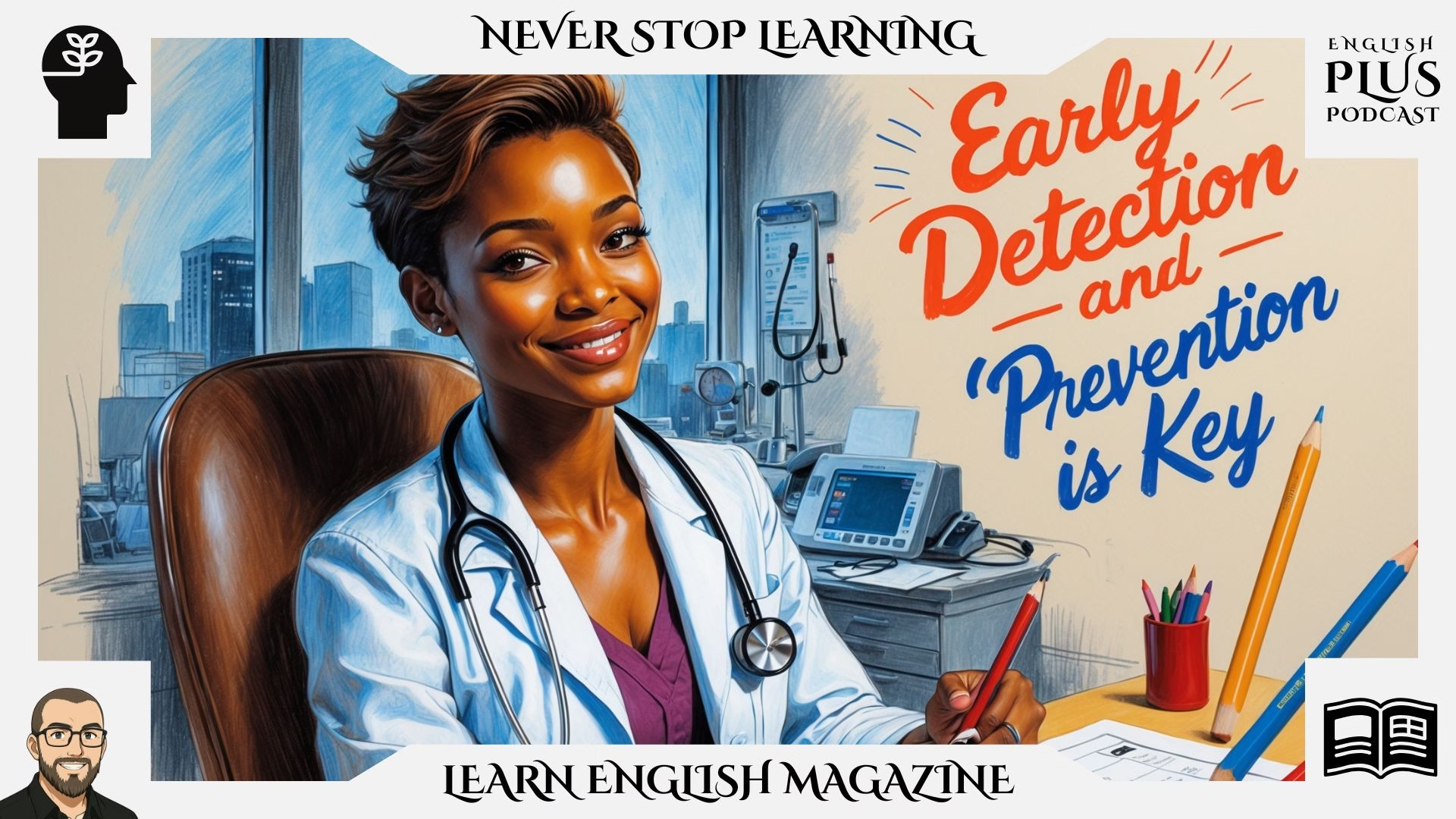Introduction: How to Approach This Lesson
Welcome to this grammar-focused lesson! Today, we’re tackling the topic of regular health check-ups and their significant benefits, while simultaneously honing your advanced English grammar. The best way to benefit from this material is to first read the main text attentively. Observe how sentences are constructed, how information is presented, and the specific vocabulary and grammatical patterns employed. Note any structures that seem complex or particularly effective. Afterwards, the grammar analysis section will break down selected features from the text, explaining their usage and nuances. Let’s get started on a healthy dose of grammar practice!
Main Text: Proactive Prevention: Unpacking the Lifesaving Benefits of Regular Health Check-ups
In our fast-paced lives, where immediate concerns often overshadow long-term well-being, preventative healthcare can sometimes take a backseat. Many individuals tend to visit a doctor only when symptoms manifest, viewing healthcare primarily as a reactive measure rather than a proactive strategy. However, this approach overlooks the profound, potentially life-saving benefits of undergoing regular health check-ups. These routine examinations, far from being an unnecessary expense or inconvenience, represent a crucial investment in one’s future health and longevity. It’s essential, therefore, to understand why prioritizing these appointments is so advantageous.
Perhaps the most significant benefit is the potential for early detection of diseases. Many serious conditions, such as certain types of cancer, cardiovascular disease, and diabetes, often develop silently in their initial stages, exhibiting few, if any, noticeable symptoms. Regular screenings and tests, which are typically part of a comprehensive check-up, can identify these conditions long before they become advanced or life-threatening. For instance, routine blood pressure measurements can detect hypertension early, allowing for timely intervention through lifestyle changes or medication to prevent strokes or heart attacks. Similarly, cancer screenings like mammograms or colonoscopies have been proven to save lives by catching malignancies when they are most treatable. Had these conditions remained undetected until symptoms emerged, the prognosis might have been considerably poorer.
Beyond detecting major diseases, regular check-ups provide an opportunity to assess overall health status and identify risk factors. Doctors can evaluate lifestyle habits – including diet, exercise levels, smoking status, and alcohol consumption – and provide personalized guidance on how to make healthier choices. Blood tests can reveal cholesterol levels, blood sugar levels, and indicators of kidney and liver function, offering a snapshot of internal health. Identifying risk factors early on, such as prediabetes or high cholesterol, empowers individuals to take preventative action, potentially averting the onset of chronic disease altogether. This proactive approach is significantly more effective, and often less costly, than managing a fully developed chronic condition.
These appointments also serve as a vital platform for updating vaccinations and discussing preventative measures. Vaccinations are not just for children; adults require booster shots for certain diseases (like tetanus) and may need vaccinations against illnesses like influenza or pneumonia, particularly older adults or those with specific health conditions. A check-up provides the perfect opportunity for a healthcare provider to review a patient’s immunization history and recommend necessary updates, thereby bolstering their immunity against preventable diseases. Furthermore, it allows for discussions about other preventative strategies, such as safe practices or necessary lifestyle adjustments based on age and risk profile.
Establishing a consistent relationship with a healthcare provider is another subtle yet important benefit. Having a doctor who is familiar with your medical history, lifestyle, and baseline health makes it easier for them to notice subtle changes over time that might indicate an emerging health issue. This continuity of care fosters trust and open communication, making patients feel more comfortable discussing sensitive health concerns. Rather than seeing a different doctor each time an issue arises, maintaining a relationship with a primary care physician allows for more holistic and personalized care. This doctor becomes your health partner, guiding you through different life stages and health challenges.
From a broader perspective, regular check-ups contribute to overall public health and can reduce healthcare costs in the long run. Early detection and prevention lessen the burden of treating advanced diseases, which are often complex and expensive to manage. By encouraging preventative care, health systems can potentially allocate resources more efficiently, focusing on keeping populations healthy rather than solely treating sickness. While the upfront cost of a check-up might seem like an expense, it should be viewed as an investment that can yield substantial savings – both financial and in terms of quality of life – down the line. Consider the cost of managing complications from uncontrolled diabetes versus the cost of routine blood sugar tests and lifestyle counseling; the former invariably dwarfs the latter.
In conclusion, the arguments in favour of regular health check-ups are compelling. They empower individuals by providing knowledge about their health status, enabling early detection of potentially serious conditions, and offering guidance on preventative measures. They foster crucial relationships with healthcare providers and contribute to more sustainable healthcare systems. Instead of waiting for illness to strike, adopting a proactive stance towards health through routine examinations is one of the most effective actions one can take to safeguard their well-being. Making time for these appointments isn’t a luxury; it’s a fundamental aspect of responsible self-care.
Grammar Analysis: Unpacking the Structures
Let’s investigate some of the grammar used in the text about health check-ups. Understanding these structures will enhance the clarity and sophistication of your English, aiding your performance in international exams.
Purpose Clauses (using ‘to infinitive’, ‘in order to’, ‘so as to’)
- Example: “…allowing for timely intervention… to prevent strokes or heart attacks.” / “…empowers individuals to take preventative action…” / “…focusing on keeping populations healthy rather than solely treating sickness.” (Implied purpose of focus) / “In order to maintain good health…” (Could be added) / “So as to avoid complications…” (Could be added)
- Explanation: Purpose clauses explain why an action is done. The most common way to express purpose is using the infinitive (to + base verb). In order to and so as to are more formal alternatives, often used at the beginning of a sentence or for emphasis. So that + clause (e.g., …so that they can prevent strokes) is another way, often used when the subject of the main clause and purpose clause are different.
- Nuance: To-infinitive is the most frequent and neutral. In order to and so as to add a degree of formality. Use so that when you need a full clause, especially if the subjects differ. Negative purpose is expressed with so as not to or in order not to (e.g., Take notes so as not to forget.).
- Common Mistake: Using ‘for + -ing’ to express purpose (Incorrect: I study for passing the exam. Correct: I study to pass the exam.). ‘For + -ing’ usually expresses the function of an object (e.g., This knife is for cutting bread.) or the reason for something abstract (He was punished for lying.).
Comparative and Superlative Structures (including ‘rather than’, ‘more…than’)
- Example: “…viewing healthcare primarily as a reactive measure rather than a proactive strategy.” / “This proactive approach is significantly more effective, and often less costly, than managing a fully developed chronic condition.” / “…catching malignancies when they are most treatable.” / “…allows for more holistic and personalized care.”
- Explanation: Comparisons are essential for evaluating options and describing degrees.
- Comparatives (more…than, -er than, less…than): Used to compare two things. Adverbs like significantly, much, far, slightly can modify comparatives.
- Superlatives (the most…, the -est, the least…): Used to compare one thing with all others in its group.
- Rather than: Used to show preference or contrast between two nouns, verbs (-ing form or base form depending on context), or clauses. Here, it contrasts reactive measure and proactive strategy.
- Nuance: The structure after than or as should ideally be parallel to the structure being compared (e.g., “Managing the condition is less effective than taking preventative action”). Superlatives are often used with the present perfect + ‘ever’ (e.g., “This is the best check-up I’ve ever had.”).
- Common Mistake: Incorrect formation (e.g., more better, the most fastest). Using than when as is needed (in as…as comparisons). Errors in parallel structure after than or rather than. Forgetting ‘the’ before superlatives.
- Explanation: Comparisons are essential for evaluating options and describing degrees.
Present Perfect Tense (connecting past and present)
- Example: “…cancer screenings like mammograms or colonoscopies have been proven to save lives…” / “Had these conditions remained undetected…” (Past perfect in conditional, but related concept) / “Having a doctor who is familiar…” (Perfect participle, related)
- Explanation: The present perfect (have/has + past participle) is used to talk about:
- Past actions with present results: “Screenings have been proven to save lives” (The proof happened in the past, but the fact is relevant now).
- Experiences up to now: “Have you ever had a full check-up?”
- Actions that started in the past and continue to the present: “He has been my doctor for ten years.”
- Recent past actions (especially with ‘just’): “I have just finished reading the article.”
- Nuance: It contrasts with the simple past, which talks about completed actions at a specific past time. The present perfect emphasizes the connection to the present. The passive form (have been proven) is common in formal or scientific contexts.
- Common Mistake: Using simple past when present perfect is needed (especially when talking about life experiences or actions with present relevance). Using present perfect when simple past is required (when specifying the time of a completed past action, e.g., Incorrect: “I have visited him yesterday.” Correct: “I visited him yesterday.”).
- Explanation: The present perfect (have/has + past participle) is used to talk about:
Noun Phrases with Prepositional Modifiers
- Example: “…the potential for early detection of diseases.” / “…indicators of kidney and liver function…” / “…the burden of treating advanced diseases…” / “…an investment in one’s future health and longevity.” / “…guidance on how to make healthier choices.”
- Explanation: Complex noun phrases are often built by adding prepositional phrases after a head noun. These phrases specify or describe the noun (e.g., What kind of potential? Potential for early detection. Detection of what? Detection of diseases). Different nouns often collocate with specific prepositions (potential for, indicators of, burden of, investment in, guidance on).
- Nuance: Using these structures allows for concise and precise expression, packing information densely. Mastering noun + preposition collocations is key to sounding natural.
- Common Mistake: Choosing the wrong preposition after a noun (e.g., *reason of* instead of reason for). Making the noun phrase overly long and difficult to parse.
Keep Practicing!
We’ve explored the vital role of regular health check-ups and examined grammatical tools like purpose clauses, comparative structures, the present perfect tense, and complex noun phrases. Recognizing these is step one; confidently using them is the aim. When you discuss health, prevention, or comparisons, try expressing purpose clearly with infinitives, use comparatives accurately, connect past and present with the present perfect, and build precise descriptions using noun phrases. Keep observing these structures in authentic materials and practice incorporating them into your own speaking and writing. Your grammatical health will surely improve! Well done!











0 Comments